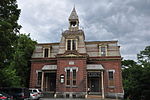Ranger Bridge
1917 establishments in New HampshireBridges completed in 1917Bridges completed in 1923Bridges in Grafton County, New HampshireBridges in Orange County, Vermont ... and 16 more
Bridges of the United States Numbered Highway SystemBridges over the Connecticut RiverBuildings and structures in Newbury, VermontInterstate vehicle bridges in the United StatesNew Hampshire building and structure stubsNew Hampshire transportation stubsNortheastern United States bridge (structure) stubsRoad bridges in New HampshireRoad bridges in VermontSteel bridges in the United StatesThrough arch bridges in the United StatesU.S. Route 2Vermont building and structure stubsVermont transportation stubsWells River, VermontWoodsville, New Hampshire

The Ranger Bridge (officially Veterans Memorial Bridge) between Wells River, Vermont and Woodsville, New Hampshire, is a three-hinged steel arch truss bridge over the Connecticut River. It was built in 1923 to replace a 1917 bridge. This is the oldest steel arch bridge over the Connecticut River.
Excerpt from the Wikipedia article Ranger Bridge (License: CC BY-SA 3.0, Authors, Images).Ranger Bridge
Central Street,
Geographical coordinates (GPS) Address External links Nearby Places Show on map
Geographical coordinates (GPS)
| Latitude | Longitude |
|---|---|
| N 44.153888888889 ° | E -72.040833333333 ° |
Address
New Hampshire/Vermont Veterans Memorial Bridge
Central Street
03785
New Hampshire, United States
Open on Google Maps







